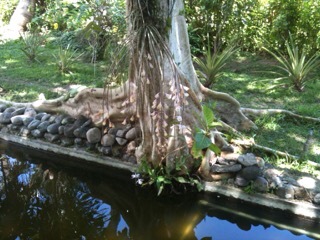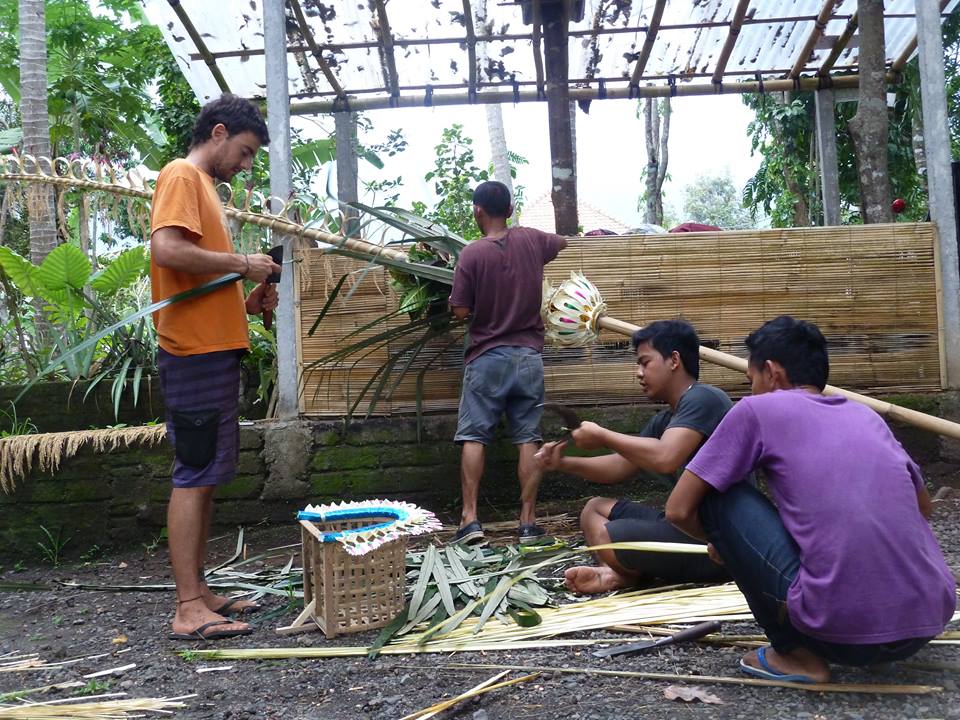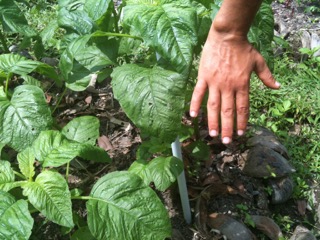Johanes Wibowo, PDC Teacher
/Jiwa Damaiis a learning space. We bring knowledge from all the corners of the world and share it with people who in turn will spread it to all the corners of the world. During our Permaculture Design Course Through the Heart in February, we have an international team of experts: Neil Willmann, Daruma eco farm founder in Thailand; Margret Rueffler, founder of Jiwa Damai permaculture center Bali and Lagu Damai foundation and Johanes Wibowo, head of Green School Bali gardens.
In this article we will tell you more about Johanes Wibowo. You can read more about our facilitators here. And you can find more information about the course here.
It wouldn’t have been right to do a permaculture design course in Indonesia without accessing the local knowledge. Johanes Wibowo is a certified Permaculture Designer with years of experience teaching locals on the islands of Sumatra, Kalimantan and East Java (Indonesia) in the transition from conventional to organic farming. He received his training in traditional Javanese farming methods at KPTT Salatiga in central Java as a designer and planer.
We asked him why people should study permaculture and who should attend this kind of course. His answers came from the heart showing how much he loves nature.
Why permaculture?
Permaculture reminds me of the time when I was a kid. In my village we were growing so many trees, there was a huge variety. Permaculture talks about the diversity of plants or animals. In my village they were following the traditional calendar: the wind season, the rain season, the dry season, the breeding season and so on. They were following the rhythm of nature so they were using in a sense Permaculture principles.
Permaculture means learning from the nature. And there are so many new things to discover every day. This is how permaculture design works. Therefore, it is a life long learning process and no matter how many permaculture courses one had before, each course brings something new. One can read a book on Permaculture design but the reality is always different because every experience is different.
Jiwa Damai is following the permaculture standard so it is a great place to learn about the permaculture principles here. The garden is very generous and one can experience a lot and explore different possibilities.
Who should attend the course?
I think everybody should attend this course. People have to learn what nature needs. It isn’t only farmers or permaculture designers, or only for students or trainers. Everybody could come and should come. Because nature is not a place out there somewhere. It is everything that surrounds us: sun, energy, plants, animals. And everyday we should get closer to nature.
When I give trainings I am really happy if people tell me afterwards that they applied what they learned from me in their own gardens, in their own offices, in their own schools or in their own beautiful spaces.
Neil Willmann, PDC Teacher
/Less than one month to go until the February Permaculture Through the Heart Design Course begins! Here, at Jiwa Damai we are getting very excited. Our international team of specialists is waiting for you!
Although we are very eager to know you, let’s first introduce our facilitators: Neil Willmann, Daruma ecofarm founder in Thailand; Margret Rueffler, founder of Jiwa Damai permaculture center Bali and Lagu Damai foundation and Johanes Wibowo, head of Green School Bali gardens. Find more about the structure of the course here.
In this blog post we will talk about Neil Willmann but follow us. Soon we will come back with information about our other facilitators.
Neil Willmann is originally from Chicago. Neil’s academic studies include a degree in oceanography from the university of Hawaii where he worked on recirculating, marine aquaculture systems. Later, he returned to his hometown to complete another degree in physics. Physics, particularly thermodynamics, serves as much of the foundation for ecology in general and even specifically the origins of much of permaculture design theory.
Neil has traveled, lived and worked in many parts of the world and recently (2007) settled down in Thailand, about an hour outside of Bangkok. He currently teaches physics, energy studies, and engineering design methodology at Asian University of Science and Technology where he also conducts research in ecological system engineering using engineering mathematics to validate eco-agrology methods (such as organic farming).
Additionally, Neil is the executive manager of Daruma Eco-Farm and co-founder of the Mosaic School, the first full-time primary school based on permaculture principles offering an alternative, holistic ecological conscious education. Daruma, under Neil’s direction, has hosted numerous permaculture courses, natural and earth building courses, Thai massage courses, and more. Neil has led and instructed many students in permaculture including many credited undergraduate and graduate study programs with universities in the USA, Canada, France, Netherlands, Denmark and Germany.
Neil is passionate about life-long learning. “The only true ‘expert' in ecological engineering design is Nature. Because of this, permaculture design promises a creative, lifelong learning capacity that will always be rewarding.” As for teaching permaculture, Neil says, “When it comes to teaching subjects like permaculture, ‘rewarding’ doesn’t even begin to describe the feeling of giving the gift of a more complete understanding of a complex subject such as ecology, and a foundation of design methodology that allows others to confidently go forward and effect meaningful change in the world.”
Tropical Christmas at Jiwa Damai
/No matter how far, how hot or how different it may be from where you usually celebrate it, as soon as the last week of the year approaches you start longing for Christmas. So even if you are in the tropical parts of the planet, as we are here, at Jiwa Damai, in sunny Bali, there are still things you can do to calm that wish of a white Christmas.
But since we’re pretty short on snow and Christmas trees, we’ve got our decorations on another beautiful tree, just close to the place we’ll have our Christmas dinner, almost as, or even better than in a colder climate.
Christmas it’s great in itself, who said you have to be freezing to enjoy it!
But we are in Bali and each year we also celebrate the Galungan - Kuningan. Therefore, our interns, volunteers and staff have prepared also a Balinese Penjor. Here are some pictures.
Find out more about the Balinese celebration here.
See more photos on our Facebook Page!
Jackfruit
/Mirka, our lovely Lithuanian volunteer it holding up one of our gigantic jackfruits weighing in at 5 kg. Jackfruit is extremely versatile. We use it, cut into small pieces, still green, as an aromatic vegetable full of minerals and vitamins. As a ripe fruit with its beautiful yellow small fruits nestled in its housing it makes an incredible refreshing desert or just like this. At Jiwa Damai we also remove the kernels inside each saffron yellow small fruit and we dry it in our dehydrator.
Compost again
/One can not have enough of this wonderful mixture, which rejuvenates the earth and soil in a very short. At #JiwaDamai we use #organic #compost only. In this case we applied the 18 day Berkeley method of compost making and made 6 nice compost heaps. Layers of leaves, dried grass, some nitrogen carrying plants, small branches, some ashes from our burnt coconut shells as well as some of our own grown IMO (individual micro organisms). The whole team participated to put it together as well as our wonderful volunteers. After the first 4 days we turned the heaps for the first time, and already quite a lot of heat had developed. The inner was turned outer and the outer became the inner. After this we turned it very two days. It is incredible to see how all the ingredients mix and fuse more or less into one consistency.
The pictures you see is day 16 and two more days to go before it will be ready to use.
Compost Tea
/Have your heard about #compost tea? It’s a concoction that is supposed to supercharge your garden. Does it work? I don’t know and I don’t think anyone can say so definitively. Let me explain why. Recipes for compost tea have been around for a couple of thousand years, but it fell into disuse. Fortunately, we’re experimenting with it again. Trying to figure out how best to make it and how best to use it. Compost tea is not that complicated to make. It’s simply a liquid soil additive that’s made from steeped compost. Here’s some DIY instructions on how to make an aerated compost tea (via the Pennsylvania EPA). It’s also possible to make an anaerobic version. Basic equipment. Start with a 5 gallon bucket, a gallon of mature compost, and a cheesecloth. To aerate it, get an inexpensive aquarium pump, some pump tubing (you can cut it into the lengths you need), and a gang valve (to divide the air supply into several streams).
Put about four gallons of water into the bucket. If you are using tap water, make sure you remove the chlorine before you add the compost to the mixture. How? Let it sit in the bucket overnight or bubble air through it for an hour or so. The chlorine will evaporate. Don’t overfill the bucket. Leave four to six inches of space for bubbles to pop. If you want to accelerate the process add some unsulphured molasses to the mixture. Turn on the air pump and let it run for 2-3 days.
When ready, strain it with a cheesecloth. It should smell earthy. If not, discard it. Return solids to the compost pile. Finally (below), put it to use. So why would you go through the trouble to produce compost tea? On a basic level, compost tea makes the nutrients in the compost more accessible to your plants. In this way, it serves the role of a weak, organic fertilizer that you can apply routinely. That’s useful. The advanced reason is that it is a way to speed up the development of beneficial organisms in your garden. Why? Compost tea is supposed to create a super-colony of bacteria and other organisms that can rapidly set up shop in your soil, to support your plants. Sounds great in concept, however, there’s a problem.
We know almost nothing about the complex web of microorganisms in the soil and in our bodies. It’s very big and very complex system: a healthy human body is the host of a 100 trillion strong bacteria ecosystem that supports and protects us in ways we’re just beginning to learn about.
As a result, it’s going to take some time to figure out.
JOHN ROBB
Gifts from the garden
/Passion fruit and pineapples are looking beautiful. Jiwa Damai has about 100 pineapple plants which come to fruition at different times. Once the pineapple is eaten its green top cut of, this top will be right away replanted and a new pineapple will grow there. Passionfruit is a beautiful vine which has by now covered our wooden Lumbung in the garden and give is it a very enchanted touch. The fruit is slightly accede and very refreshing.






















